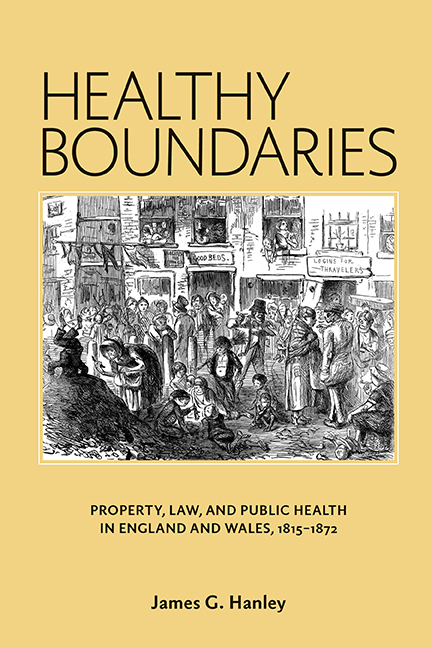Book contents
- Frontmatter
- Dedication
- Contents
- Acknowledgments
- Abbreviations
- Introduction
- 1 The Laws of Nuisance Before 1846: Property, Health, and Democracy in the Age of Reform
- 2 Private Benefit and Public Service: Paying for Sewers Before 1848
- 3 The Boundaries of Health, 1848–70
- 4 The Benefits of Health: London, 1848–65
- 5 Healthy Domesticity, 1848–72
- Conclusion
- Notes
- Bibliography
- Index
5 - Healthy Domesticity, 1848–72
Published online by Cambridge University Press: 07 May 2022
- Frontmatter
- Dedication
- Contents
- Acknowledgments
- Abbreviations
- Introduction
- 1 The Laws of Nuisance Before 1846: Property, Health, and Democracy in the Age of Reform
- 2 Private Benefit and Public Service: Paying for Sewers Before 1848
- 3 The Boundaries of Health, 1848–70
- 4 The Benefits of Health: London, 1848–65
- 5 Healthy Domesticity, 1848–72
- Conclusion
- Notes
- Bibliography
- Index
Summary
Previous chapters in this book have argued that local authorities actively and effectively used new or newly conceived concepts of the public's health to redefine healthy things, places, and properties. In this chapter, I explore the boundaries of healthy domesticity. I focus on quotidian practices of private rights, using the drainage of private property and the control of lodging houses as my examples. I choose these two examples because although in each case the state crossed a domestic threshold, it did so in different ways. Healthy drainage allowed the state into the home, as it were, shifting the boundary between the state and the individual, while healthy lodging houses drew a new if ill-defined boundary between individuals, demarcating those entitled to certain private rights from those not. Healthy boundaries were exclusive as well as inclusive.
I also choose these examples because they illustrate the different sorts of difficulties that the central and local state confronted in regulating aspects of domestic life. Active opposition in both cases was rooted in long-standing concerns over the sanctity of domestic arrangements and the rights of private property. But those anxieties were inflected by supplementary concerns. In the case of private drainage, opposition was exacerbated by the identification of house drainage as a private benefit. This fundamentally ideological identification was formalized for the first time in 1848. It structured and seriously limited the provision of house drainage for the entire nineteenth century, and it triggered, yet again, local debate about how the costs of delivering health to the poor were going to be distributed. Traditionally conceived private property rights also did not fully determine the boundaries of healthy lodging. The emergence of “common lodging houses” as the only houses with lodgers regulated at mid-century, and the form that regulation took, cannot be understood apart from an ideology of domesticity that simultaneously prohibited and permitted regulation, policing some domestic arrangements even as it protected others.
In the first three sections of this chapter, I focus on the history of private drainage. When looked at from a national perspective, this history is complex. Towns employed a wide variety of waste-management systems, from cesspits to dry conservancy to water carriage with water laid on or not, with each of these arrangements potentially inside or outside the house.
- Type
- Chapter
- Information
- Healthy BoundariesProperty, Law, and Public Health in England and Wales, 1815–1872, pp. 111 - 131Publisher: Boydell & BrewerPrint publication year: 2016



